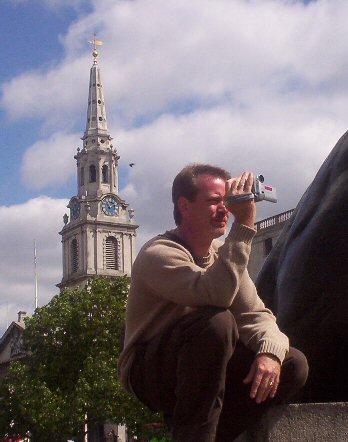-
On 8/07/2006 08:05:00 AM, DaveScot waxed damned near poetic whilst opining...
-
That's the observable universe. No one knows how big the entire universe is.
Further reading.
-
On 8/07/2006 08:31:00 AM, Unknown waxed damned near poetic whilst opining...
-
That's the observable universe. No one knows how big the entire universe is.
Wouldn't the observable universe be the 14 billion light years (in each direction) from your article, but the 156 billion light years be the whole tamali?
And if so, how do they come up with that? If nothing goes faster than light, and the universe is 14 or 15 billion years old, how did anything get farther away than 28 or 30 billion light years (if we're at one end, and the farthest thing is at the other)? And how would we know that, if we can't see any farther than 14 or 15 billion light years away?
Me and Janie had this same discussion a week or two ago, and it seems like if we're at the center, we should be able to observe 15 billion light years in each direction. That means we can see 30 billion light years of universe. Since we're not at the center (we aren't, right?) then shouldn't we see the edge in one direction?
If nothing can go faster than light, and the universe is 15 billion years old, that still means 30 billion light years across.
-
On 8/07/2006 08:38:00 AM, Unknown waxed damned near poetic whilst opining...
-
You know, I thought I understood this.
I was wrong.
-
On 8/07/2006 08:39:00 AM, Unknown waxed damned near poetic whilst opining...
-
For the second time ever.
-
On 8/07/2006 09:18:00 AM, blipey waxed damned near poetic whilst opining...
-
The answer lies in "the inflationary universe" theory. Yes, the observable universe would be 15 billion years old.
But the inflationary theory supposes that the fabric of space-time expanded (is expanding) and this causes the "Size" of the universe to increase faster than the speed of light.
Way too simplistic, but hey, I'm an actor. I'm sure some cosmologist will be happy to explain it better.
For your own edification, Brian Green's The Fabric of the Cosmos is a very enterteining book about difficult material.
My only little nitpick is that he presents string theory in perhaps too glowing a light. In a book for the layman, he seems to present string theory as more solid than I think cosmologists in general think it is. I may be wrong about that, though. And he does explain some of the down-sides of the present state of string theory.
-
On 8/07/2006 09:34:00 AM, Zachriel waxed damned near poetic whilst opining...
-
corporal kate: "Me and Janie had this same discussion a week or two ago, and it seems like if we're at the center, we should be able to observe 15 billion light years in each direction."
Edge and center have no specific meaning when discussing the structure of the cosmos. Consider the simpler case. Eratosthenes determined the size of the Earth in the third century (paraphrased from a number of sources).
--
The Babylonians recorded many lunar eclipses. All were sections of a circle leading to the conclusion that the Earth was a sphere.
Eratosthenes knew that in Syrene, far to the south of Alexandria, "At noon on the summer solstice, we can see the bottom of a deep well." The Sun in Alexandria at the same time Erastosthenes measured to be 1/50th the circumference of a circle off the zenith. Thus the distance between the two cities must be 1/50th the circumference of the Earth.
A walker measured the distance in paces, and the result was remarkably accurate. Using similar methods, the Greeks also made reasonable estimates of the distances to the Sun and Moon.
--
How far could Eratosthenes *see*? Where is the edge of the Earth? Where is the center of the Earth's surface?
Davescot is correct in pointing out that this concerns only the universe that we can deduce exists. There may be more outside our ability to discern.
-
On 8/07/2006 11:07:00 AM, Lifewish waxed damned near poetic whilst opining...
-
The classic model of "inflationary universe" is to paint a bunch of dots (stars) on the surface of a balloon (rubber = fabric of universe) and blow it up. Watch as the dots move apart.
Now try to imagine the same effect with a four-dimensional balloon ;pirate:
Using this model, the Hubble constant et al would give us the size of the actual entire universe. There could of course be other universes (in fact physicists have been proposing stacks thereof to account for the weakness of gravity - it sort of bleeds away) but that's a different issue.
-
On 8/07/2006 09:42:00 PM, JanieBelle waxed damned near poetic whilst opining...
-
Thanks guys, all three of you. Between all of your explanations and examples, it's somewhat clearer to the two of us now.
We think what you're saying is that it's like two objects on a flat piece of spandex. The two objects are moving away from each other, but at the same time, the spandex is being stretched. So while each object might be moving 5 mph in relation to the spandex, since the spandex is also stretching, they are moving at 20 mph away from each other.
Is this kind of how it is?
So the marbles or whatever can only move at the speed of light in relation to the spandex, but could be moving at ten times the speed of light in relation to each other, depending on how fast the spandex is stretching.
Is there a speed limit on the spandex?
Kate and I are really hoping that's a good analogy, otherwise we're both lost again.
-
On 8/08/2006 10:22:00 AM, Zachriel waxed damned near poetic whilst opining...
-
janiebelle: "Is there a speed limit on the spandex?"
The speed of light limitation only applies to movement within space-time, not to space-time itself. Inflation Theory predicts a very rapid expansion of the universe in the first few moments of the Big Bang. Inflation Theory is given a great deal of credence because it accurately predicts the proportions of elements (primarily hydrogen and helium) in the early universe, as well as details of energy distribution in the Cosmic Background Radiation.
-
On 8/08/2006 10:29:00 AM, JanieBelle waxed damned near poetic whilst opining...
-
Thanks Zachriel.
I wonder if there's a way to take advantage of that to bend the speed limit enough to make interstellar flight possible...
I'm terribly frustrated with the whole space shuttle thing. Going around in circles in low earth orbit doesn't seem to be very productive to me. Much like the whole Iraq invasion thing, I support the astronauts, but not the mission per se.
And going back to Apollo-style capsules with this new thingamabob seems like another step backwards. I'd really like to hop on the Enterprise and go visit the Purple Octopus Aliens from 55 Cancri.
Is anyone making any real progress toward that? Near as I can tell on the web, nobody is even trying.
That's depressing.
Kisses,
JanieBelle
-
On 8/08/2006 10:47:00 AM, Zachriel waxed damned near poetic whilst opining...
-
JanieBelle: "I'd really like to hop on the Enterprise and go visit the Purple Octopus Aliens from 55 Cancri."
That's what "warp drive" is all about, bending space-time.
And the last time I visited 55 Cancri, the Octopi were orange —but I understand this was because they were mating.












